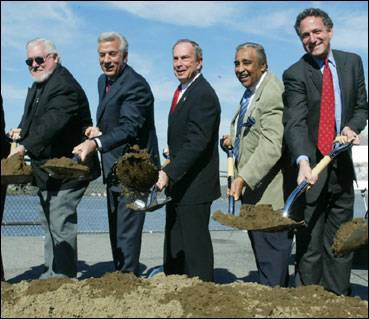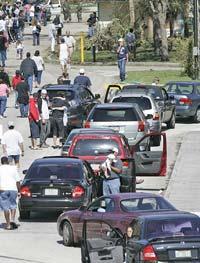
FOR IMMEDIATE RELEASE
PR- 411-05
October 31, 2005
MAYOR BLOOMBERG AND CONGRESSMAN RANGEL BREAK GROUND ON WEST HARLEM PIERS
$18.7 Million Project To Revitalize West Harlem Waterfront
Mayor Michael R. Bloomberg and Congressman Charles B. Rangel today broke ground on construction of the West Harlem Piers, an $18.7 million project that will connect West Harlem to the rest of the Manhattan waterfront greenway. The project is a part of the City's West Harlem Master Plan that the Mayor announced in October of 2002, the goal of which is to revitalize the area between 125th and 135th Streets, Broadway and the Hudson River in West Harlem. The Harlem Piers project calls for a new bicycle and pedestrian path, a docking pier, a recreational and fishing pier, and landscaped open space that will reclaim the waterfront for pedestrian and recreational use. Deputy Mayor for Economic Development & Rebuilding Daniel L. Doctoroff, Upper Manhattan Empowerment Zone (UMEZ) President & CEO Ken Knuckles, Empire State Development Corporation (ESDC) Chairman Charles A. Gargano, Economic Development Corporation (EDC ) President Andrew M. Alper, Parks Commissioner Adrian Benepe and Community Board 9 Chairman Jordi Reyes-Montblanc attended the ceremony at 125th Street at the Hudson River.
"Reconnecting residents with New York City's vast waterfront is one of our most important economic development goals," said Mayor Bloomberg. "The West Harlem Piers will bring together various recreational uses by connecting the Manhattan greenway with the northern segment of Riverside Park, creating a destination for West Harlem residents and all New Yorkers to enjoy for years to come. I want to thank Governor Pataki and the Upper Manhattan Empowerment Zone for joining the City in committing the necessary funds for this project, and the community for its work and support of the revitalization of the West Harlem waterfront."
"The West Harlem Piers project is another important step in the ongoing economic revitalization of Harlem and the Upper West Side," said Congressman Rangel. "In addition to the commercial development and housing that has already transformed our community the Piers will provide access to green grass and recreation for our residents and their children. It will also generate business opportunities and jobs in construction and operation of the facility. I've recently secured an additional $26.8 million in federal funds that will further enhance the neighborhood with construction of a ferry terminal and streetscape improvements along 125th Street from the pier to Old Broadway."
"West Harlem is reemerging as the bustling center of commerce and recreation it once was, and this project, along with our West Harlem Master Plan, are important elements of our effort to reconnect the area to the surrounding neighborhoods and greater Manhattan, both physically and economically," said Deputy Mayor Doctoroff.
"Through a $4 million commitment from New York State, Governor Pataki continues his determination to revitalize and spur redevelopment within Harlem's historic communities. Restoring the West Harlem Piers is a masterful plan to reestablish the State's waterfront heritage, while giving these piers back to the community," said ESDC Chairman Gargano. "This latest access to the waterfront will also improve transportation and allow for new recreational uses for the community. The State will continue to utilize our resources to encourage economic development opportunities as we reaffirm our dedication to the renaissance of Harlem."
The Army Corps of Engineers approved the project last week, clearing the last regulatory hurdle before construction can begin. Work will begin on the project by the end of the year, and it is expected to be completed by spring 2007. The Upper Manhattan Empowerment Zone contributed more than $6 million for this project, with the State adding more than $4 million and the City providing more than $3 million. The Manhattan Borough President, the City Council, the State Department of Parks and the Port Authority of New York and New Jersey, among others, are providing additional funding for a total of $18.7 million.
The West Harlem Piers will improve City-owned land by transforming a parking lot between 125th and 135th streets into an attractive and accessible waterfront amenity. The new recreational pier will support various activities including fishing, water tours, boating and ecological exploration. The new pier will accommodate a variety of vessels with the main portion allowing excursion boats and water taxis to dock at West Harlem. The area will be landscaped attractively with new plantings and recreational areas, and the bicycle and pedestrian path will provide a critical link in the waterfront greenway, connecting Cherry Walk on the southern end of the site with the northern segment of Riverside Park. W Architecture and Landscape LLC designed the improvements, with support from DMJM+Harris and Philip Habib.
"The Harlem Piers reclamation represents a renewal of one of the City's most important waterfront resources," said UMEZ President & CEO Knuckles. "The people of Harlem have long desired a more accessible and attractive connection to the Hudson River. We believe that this project will fulfill their wishes. UMEZ is proud to be a part of the city-state partnership that has made this day possible."
Mayor Bloomberg announced the West Harlem Master Plan in October of 2002 with the goal of revitalizing the area between 125th and 135th Streets, Broadway and the Hudson River in West Harlem. The plan calls for the transformation of neglected City-owned land, various transportation improvements to support the neighborhood's growth, and land-use policies to promote a greater variety of uses.
"125th Street is a through street and a crucial access point to get to the waterfront on the west side," said City Planning Director Burden. "In conjunction with the West Harlem Waterfront improvements, we are working with the community on a 125th Street River-to-River study to create a comprehensive development framework to catalyze and invigorate this important corridor."
"Over the past four years, Parks & Recreation has made great progress in the development of the citywide waterfront greenway," said Parks Commissioner Benepe. "The West Harlem Piers
will provide a vital permanent link to the Hudson River and demonstrates our continued commitment to expanding and improving our waterfront property."
City Planning and EDC have worked closely with the community, including Community Board 9 and West Harlem Environmental Action, to advance plans for the area, receiving extensive input from working committees made up of various stakeholders including elected officials, government agencies and community organizations.
"Making the City more livable is one of this Administration's most vital economic development goals," said EDC President Alper. "Opening up the West Harlem waterfront to residents will take us closer to achieving the goals the State, the City and the community set forth in the West Harlem Master Plan to revitalize the area."
"The Manhattanville Piers will be a great asset to the residents of Community Board 9 and West Harlem," said Community Board Chairman Jordi Reyes-Montblanc. "This is a long-awaited and much-fought-for project, which is the symbol of the rebirth of West Harlem. It is a tribute to the dedication of many community people, but particularly Maritta Dunn, who has made the Piers her project."
MEDIA CONTACT:
Edward Skyler/Jennifer Falk (212) 788-2958
Emile Milne (Congressman Rangel) (202) 225-4365
Michael Sherman/Janel Patterson (Economic Development Corporation)
(212) 312-3523













